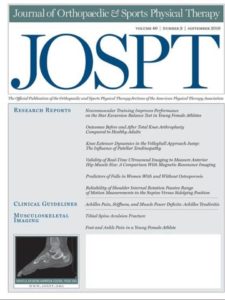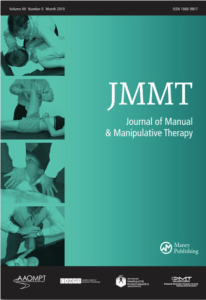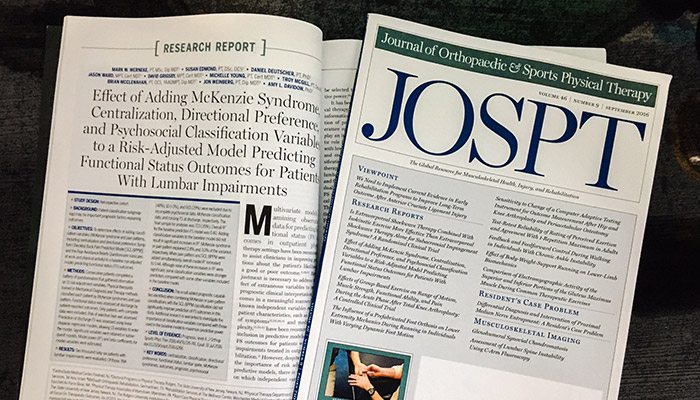With one of our primary goals of providing research-supported physical therapy to out patients, we are engaged in multiple nation-wide projects. This research and commitment to quality directly contributes to improved clinic outcomes for our patients.
Practice Based Evidence Research
A practice-based research network (PBRN) is a group of practices devoted principally to the care of patients and affiliated for the purpose of examining the health care processes that occur in practices. PBRNs are characterized by an organizational framework that transcends a single practice or study. They provide a “laboratory” for studying broad populations of patients and care providers in community-based settings.
Our Practice-based Evidence Research Network was founded in 2005 by Mark Werneke and Jon Weinberg. We joined this network in February of 2009 which brought the numbers to 9 clinicians in 8 states and included members, all active in clinical practice, in hospital-based clinics, physician-owned clinics, therapy chains and private practices.
The purpose of forming this group was two-fold:
(1) To examine the Strengths and limitations of the McKenzie (MDT) approach using practice based evidence research.
(2) To generate a large MDT Outcome database in order to compare it to other current treatment methods and classification systems.
Team members:
Mark Werneke, Dennis Hart, Daniel Deutscher, Jason Ward, David Grigsby, Dave Oliver, William Oswald, Troy McGill, Jon Weinberg, Susan Edmonds, Michelle Young, Brian McClennehan
Journal of Manual and Manipulative Therapy (JMMT) – December 2010
Aims were (1) to determine the proportion of patients with lumbar impairments who could be classified at intake by McKenzie syndromes (McK) and pain pattern classification (PPCs) using Mechanical Diagnosis and Therapy (MDT) assessment methods, manipulation, and stabilization clinical prediction rules (CPRs) and (2) for each Man CPR or Stab CPR category, determine classification prevalence rates using McK and PPC.
Results: Data from 628 adults [mean age: 52±17 years, 56% female] were analyzed. Prevalence rates were: McK – derangement 67%, dysfunction 5%, posture 0%, other 28%; PPC – CEN 43%, Non CEN 39%, NC 18%; manipulation CPR – positive 13%; Stab CPR – positive 7%. For patients positive for manipulation CPR (n = 79), prevalence rates for derangement were 89% and CEN 68%. For patients positive for stabilization CPR (n = 41), prevalence rates for derangement were 83% and CEN 80%.
Authors: David Grigsby, Mark Werneke, Dennis Hart, Jason Ward, Dave Oliver, Jon Weinberg, Troy McGill, William Oswald, Guillermo Cutrone
Journal of Orthopedic and Sports Physical Therapy (JOSPT) – January 2011
Association between directional preference and centralization in patients with low back pain.
 Primary aims were to determine (1) baseline prevalence of directional preference (DP) or no directional preference (no-DP) observed for patients with low back pain whose symptoms centralized (CEN), did not centralize (non-CEN), or could not be classified (NC), and (2) to determine if classifying patients at intake by DP or no-DP combined with CEN, non-CEN, or NC predicted functional status and pain intensity at discharge from rehabilitation.
Primary aims were to determine (1) baseline prevalence of directional preference (DP) or no directional preference (no-DP) observed for patients with low back pain whose symptoms centralized (CEN), did not centralize (non-CEN), or could not be classified (NC), and (2) to determine if classifying patients at intake by DP or no-DP combined with CEN, non-CEN, or NC predicted functional status and pain intensity at discharge from rehabilitation.
Conclusion: Findings suggest that classification by pain pattern and DP can improve a therapist’s ability to provide a short-term prognosis for function and pain outcomes.
Authors: David Grigsby, Mark Werneke, Dennis Hart, Jason Ward, Dave Oliver, Jon Weinberg, William Oswald, Guillermo Cutrone, Troy McGill
Journal of Orthopedic and Sports Physical Therapy (JOSPT) – February 2014
In subjects with neck pain, the present study aimed (1) to describe the prevalence of centralization (CEN), noncentralization (non-CEN), directional preference (DP), and no directional preference (no DP); (2) to determine if age, sex, fear-avoidance beliefs about physical activity, number of comorbid conditions, or symptom duration varies among subjects who demonstrate CEN versus non-CEN and DP versus no DP; and (3) to determine if CEN and/or DP are associated with changes in function and pain.
Conclusion: DP and, to a lesser extent, CEN represent evaluation categories that are associated with improvements in functional outcomes.
Authors: David Grigsby, Mark Werneke, Dennis Hart, Susan Edmond, Jason Ward, Dave Oliver, Guillermo Cutrone, William Oswald, Jon Weinberg, Troy McGill
Journal of Orthopaedic and Sports Physical Therapy – August 2016
Abstract: Study Design Retrospective cohort. Background Patient-classification subgroupings may be important prognostic factors explaining outcomes. Objectives To determine effects of adding classification variables (McKenzie syndrome and pain patterns, including centralization and directional preference; Symptom Checklist Back Pain Prediction Model [SCL BPPM]; and the Fear-Avoidance Beliefs Questionnaire subscales of work and physical activity) to a baseline risk-adjusted model predicting functional status (FS) outcomes. Methods Consecutive patients completed a battery of questionnaires that gathered information on 11 risk-adjustment variables. Physical therapists trained in…
Authors: David Grigsby,Jason Ward, Mark Werneke, Susan Edmond, Michelle Young,Troy McGill,Brian McClenahan,Jon Weinberg, Amy Davidow
Recognition
 We were recently recognized by the Journal of Manual & Manipulative Therapy as the winner of the 2010 John Medeiros Distinguished Author Award for ‘Prevalence of Classification Methods for Patients with Lumbar Impairments using the McKenzie Syndromes, Pain Pattern, Manipulation and Stabilization Clinical Prediction Rules.’
We were recently recognized by the Journal of Manual & Manipulative Therapy as the winner of the 2010 John Medeiros Distinguished Author Award for ‘Prevalence of Classification Methods for Patients with Lumbar Impairments using the McKenzie Syndromes, Pain Pattern, Manipulation and Stabilization Clinical Prediction Rules.’
With one of our primary goals of providing research-supported physical therapy to out patients, we are engaged in multiple nation-wide projects. This research and commitment to quality directly contributes to improved clinic outcomes for our patients.
Practice Based Evidence Research
A practice-based research network (PBRN) is a group of practices devoted principally to the care of patients and affiliated for the purpose of examining the health care processes that occur in practices. PBRNs are characterized by an organizational framework that transcends a single practice or study. They provide a “laboratory” for studying broad populations of patients and care providers in community-based settings.
Our Practice-based Evidence Research Network was founded in 2005 by Mark Werneke and Jon Weinberg. We joined this network in February of 2009 which brought the numbers to 9 clinicians in 8 states and included members, all active in clinical practice, in hospital-based clinics, physician-owned clinics, therapy chains and private practices.
The purpose of forming this group was two-fold:
(1) To examine the Strengths and limitations of the McKenzie (MDT) approach using practice based evidence research.
(2) To generate a large MDT Outcome database in order to compare it to other current treatment methods and classification systems.
Team members:
Mark Werneke, Dennis Hart, Daniel Deutscher, Jason Ward, David Grigsby, Dave Oliver, William Oswald, Troy McGill, Jon Weinberg, Susan Edmonds, Michelle Young, Brian McClennehan
Journal of Manual and Manipulative Therapy (JMMT) – December 2010
Aims were (1) to determine the proportion of patients with lumbar impairments who could be classified at intake by McKenzie syndromes (McK) and pain pattern classification (PPCs) using Mechanical Diagnosis and Therapy (MDT) assessment methods, manipulation, and stabilization clinical prediction rules (CPRs) and (2) for each Man CPR or Stab CPR category, determine classification prevalence rates using McK and PPC.
Results: Data from 628 adults [mean age: 52±17 years, 56% female] were analyzed. Prevalence rates were: McK – derangement 67%, dysfunction 5%, posture 0%, other 28%; PPC – CEN 43%, Non CEN 39%, NC 18%; manipulation CPR – positive 13%; Stab CPR – positive 7%. For patients positive for manipulation CPR (n = 79), prevalence rates for derangement were 89% and CEN 68%. For patients positive for stabilization CPR (n = 41), prevalence rates for derangement were 83% and CEN 80%.
Authors: David Grigsby, Mark Werneke, Dennis Hart, Jason Ward, Dave Oliver, Jon Weinberg, Troy McGill, William Oswald, Guillermo Cutrone
Journal of Orthopedic and Sports Physical Therapy (JOSPT) – January 2011

Association between directional preference and centralization in patients with low back pain.
Primary aims were to determine (1) baseline prevalence of directional preference (DP) or no directional preference (no-DP) observed for patients with low back pain whose symptoms centralized (CEN), did not centralize (non-CEN), or could not be classified (NC), and (2) to determine if classifying patients at intake by DP or no-DP combined with CEN, non-CEN, or NC predicted functional status and pain intensity at discharge from rehabilitation.
Conclusion: Findings suggest that classification by pain pattern and DP can improve a therapist’s ability to provide a short-term prognosis for function and pain outcomes.
Authors: David Grigsby, Mark Werneke, Dennis Hart, Jason Ward, Dave Oliver, Jon Weinberg, William Oswald, Guillermo Cutrone, Troy McGill
Journal of Orthopedic and Sports Physical Therapy (JOSPT) – February 2014
In subjects with neck pain, the present study aimed (1) to describe the prevalence of centralization (CEN), noncentralization (non-CEN), directional preference (DP), and no directional preference (no DP); (2) to determine if age, sex, fear-avoidance beliefs about physical activity, number of comorbid conditions, or symptom duration varies among subjects who demonstrate CEN versus non-CEN and DP versus no DP; and (3) to determine if CEN and/or DP are associated with changes in function and pain.
Conclusion: DP and, to a lesser extent, CEN represent evaluation categories that are associated with improvements in functional outcomes.
Authors: David Grigsby, Mark Werneke, Dennis Hart, Susan Edmond, Jason Ward, Dave Oliver, Guillermo Cutrone, William Oswald, Jon Weinberg, Troy McGill
Journal of Orthopaedic and Sports Physical Therapy – August 2016
Abstract: Study Design Retrospective cohort. Background Patient-classification subgroupings may be important prognostic factors explaining outcomes. Objectives To determine effects of adding classification variables (McKenzie syndrome and pain patterns, including centralization and directional preference; Symptom Checklist Back Pain Prediction Model [SCL BPPM]; and the Fear-Avoidance Beliefs Questionnaire subscales of work and physical activity) to a baseline risk-adjusted model predicting functional status (FS) outcomes. Methods Consecutive patients completed a battery of questionnaires that gathered information on 11 risk-adjustment variables. Physical therapists trained in…
Authors: David Grigsby,Jason Ward, Mark Werneke, Susan Edmond, Michelle Young,Troy McGill,Brian McClenahan,Jon Weinberg, Amy Davidow
Recognition

We were recently recognized by the Journal of Manual & Manipulative Therapy as the winner of the 2010 John Medeiros Distinguished Author Award for ‘Prevalence of Classification Methods for Patients with Lumbar Impairments using the McKenzie Syndromes, Pain Pattern, Manipulation and Stabilization Clinical Prediction Rules.’

